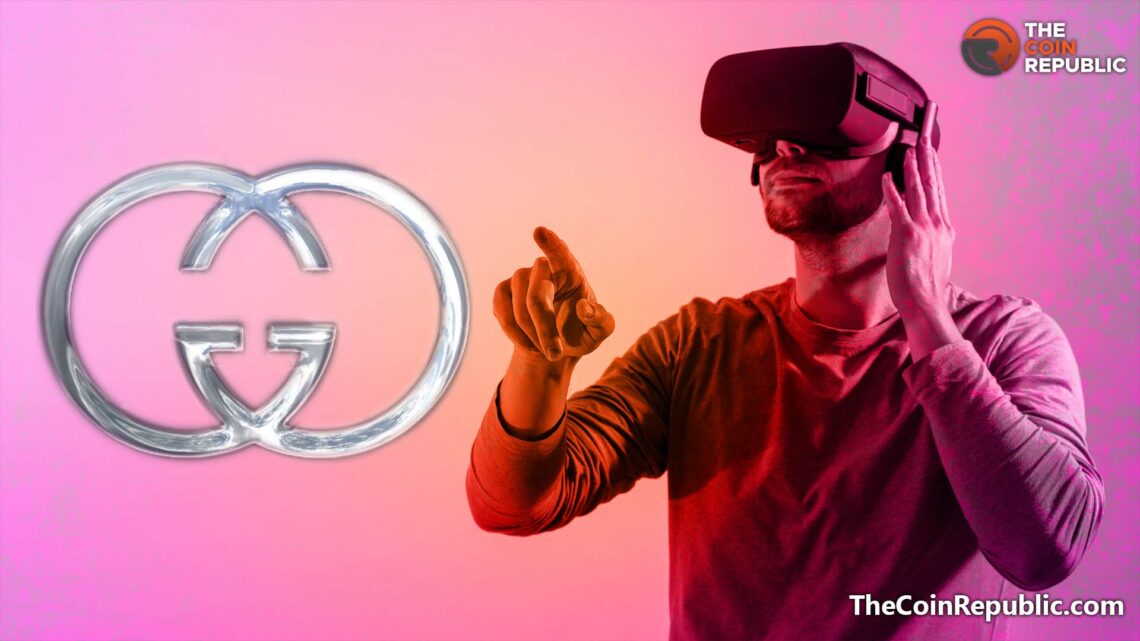- 1 Gucci to use metaverse for marketing virtual copies of their products.
- 2 Gucci has partnered with Burberry to purchase virtual space in the Sandbox Metaverse.
- 3 Dior’s digital sneakers had 2.3 million views and a sixfold return on advertising investment.
The Italian clothing and leather goods company Gucci is now running its own metaverse event in The Sandbox. The fashion label created the first significant virtual environment on the metaverse platform.
“Gucci Vault Land,” an experimental metaverse area where visitors may journey through the history of the fashion label through games and NFTs, will be featured in the Gucci experience.
The metaverse, a connected and immersive digital environment, has millions of users worldwide. Gucci’s latest initiative fits into a larger trend of well-known companies looking to take advantage of the chance to increase the sale of physical items and market virtual copies of their products to users of the metaverse.
First luxury brand to launch on NFT
The term “metaverse” is now a buzz word. Users can create interactive experiences that blend the virtual and real worlds in the 3D virtual environment known as Metaverse. People can experience products and services as well as human relationships in 3D through the metaverse.
Investment bank Morgan Stanley forecasted that by 2030, the sale of the fashion business might rise by $50 billion.
Gucci was the first high-end company to introduce an NFT. In May of last year, the company also released Gucci garden Experience on Roblox. Gucci’s endeavour fits with a trend among large companies looking to increase sales of both tangible goods and virtual replicas of their products in the metaverse.
Benefits of Metaverse
Gucci is the first high-end brand to declare that it has purchased virtual space in the Sandbox Metaverse for a store-plus-event area, where it has set up a virtual gallery showing NFT artefacts and historical clothing items. A $12.99 pair of virtual sneakers were made available for mobile augmented reality “wearing.”
By collaborating with the wildly popular online game in November, British heritage brand Burberry also made a pitch to the Gen Z audience. Minecraft, a product known for its big square aesthetics looked like a nice match for the brand’s iconic tartan “check.”
There were two components to the partnership. A £390 scarf with pixelated Burberry lettering is part of Burberry’s real-world collection that was inspired by the minecraft video game and made available to users for free download. According to Launchmetrics, a data company that examines luxury brands on social media, the effort yielded an estimated $5.2 million in return on advertising expenditures.
These kinds of studies are crucial for comprehending how the idea of luxury might have changed through time in the metaverse. In the metaverse, you may pay $5 to get a Gucci handbag if you can’t afford one in the real world, according to Alison Come, chief marketing officer of Launchmetrics. If consumers have access to virtual goods, brands anticipate that they will be more inclined to purchase the real product if they have more money. It’s a starting point for developing a relationship with the customer, she continues.
Why spend money on virtual things
A popular trend is augmented reality collaboration, which allows customers to view a 3D model of apparel or accessories from the comfort of their homes before placing an order.
Similar to famous Snapchat filters, users of the apps can direct the smartphone camera to superimpose 3D digital replicas of objects onto their faces or bodies. For sneakers and makeup, Estée Lauder, MAC, Gucci, and Dior allegedly ran AR try-on advertisements that generated direct sales. For instance, Dior’s digital sneakers had 2.3 million views and a sixfold return on advertising investment.
Steve Anderson is an Australian crypto enthusiast. He is a specialist in management and trading for over 5 years. Steve has worked as a crypto trader, he loves learning about decentralisation, understanding the true potential of the blockchain.


 Home
Home News
News









